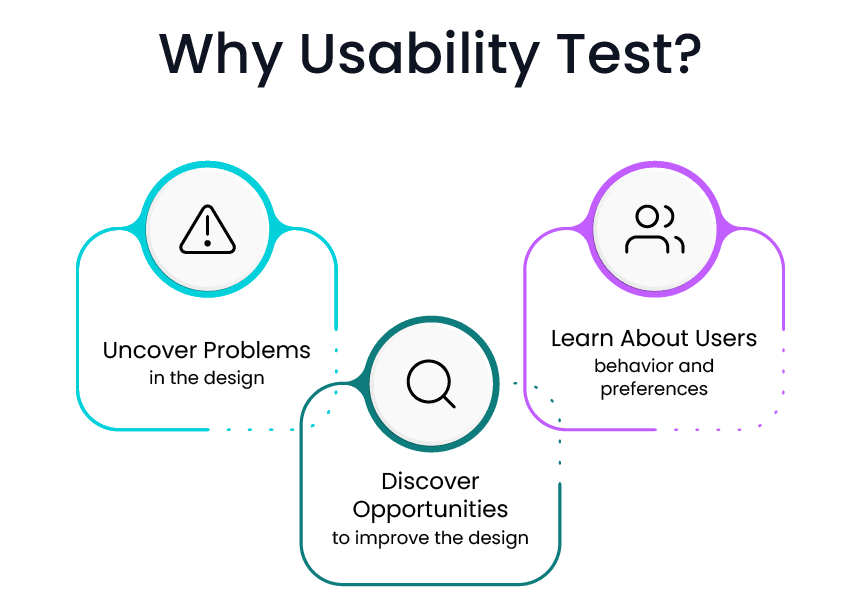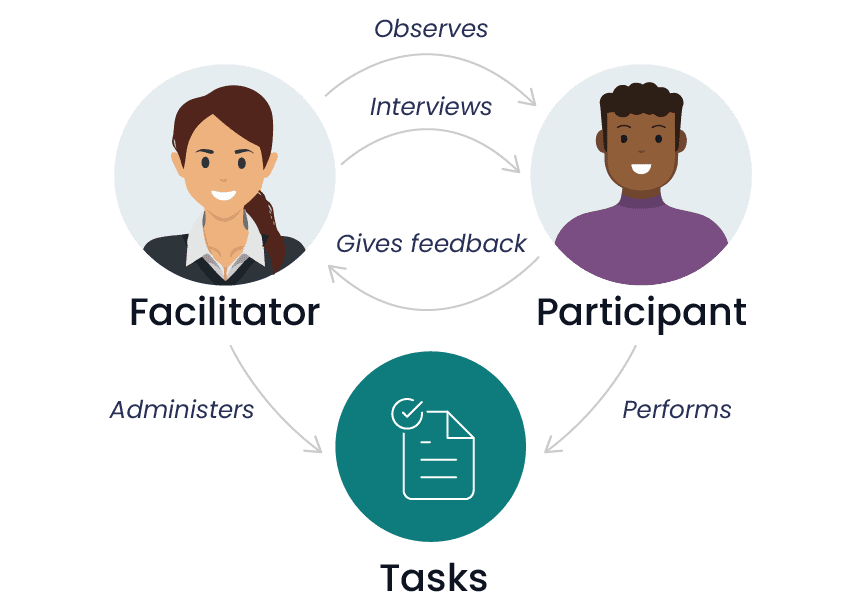Whenever an application is developed, it is built with specific objectives and features designed to deliver a desired user experience. But how do you ensure that the application actually meets user expectations and functions as intended? This is where usability testing plays a crucial role.
In this blog, we’ll explore what usability testing is, why it’s essential, and how it can help reduce development costs while improving overall product quality.

What is Usability Testing?
Also known as UX (user experience) testing, it is a software testing process where a software application is tested by real or representative users. The main purpose of user testing is to uncover the pain points in the customer journey to highlight opportunities where there is scope of improvement in the overall user experience. Thus, we can say that the goals of usability testing are:
- Identifying problems in the design of an application
- Uncovering opportunities to improve
- Learning about the target user’s behavior and preferences

Elements of Usability Testing
The core elements of usability testing are the facilitator, the tasks, and the participant.
The Facilitator: The facilitator is the administrator who assigns tasks to the participants and guides them through the testing process. The administrator provides instructions, answers the participant’s questions, and asks follow-up questions. The facilitator might ask for the user feedback based on actions and thoughts as they perform tasks.
The Participants: Participants are end-users who perform usability testing.
The Tasks: These are realistic activities that the participant might perform in their day-to-day function or role. Tasks consist of specific actions that enable the facilitator to assess how easy it is for the users or participants to complete those actions without any prior knowledge of the software.
What are Different Types of Usability Testing?
Moderated Usability Testing
Here, a facilitator (also known as moderator) guides participants through tasks and observes their behavior to gather feedback in real-time. The main goal of moderated testing is to evaluate how real users interact with a software product, identify usability issues, and understand their thoughts, frustrations, or confusion as they navigate the interface. Here, the facilitator can ask follow-up questions, clarify misunderstandings, and adapt the session based on the participant’s responses. It is often used during early-stage design to uncover critical usability problems and refine the user experience before full-scale development or deployment.
Unmoderated Usability Testing
In this method, participants give feedback on a software product independently, without guidance from a facilitator, using structured user research techniques. It is a usability testing technique where specialized tools are used to record user interactions, screen activity, and sometimes voice or written feedback. Participants follow a pre-defined set of tasks at their own pace and in their own environment, which allows researchers to observe more natural behavior. The prime advantage of this method is scalability as a large number of users can be used in less time and at a lower cost compared to moderated testing.
Remote Usability Testing
This is a software evaluation method where real users interact with the product remotely, from their own location, rather than in a controlled, in-person environment. This remote testing can be moderated (with a facilitator guiding the session via video conferencing) or unmoderated (where users complete tasks independently using online tools). User feedback is collected from a diverse audience across various geographies and real-world environments, making this approach ideal for products targeting a global user base. It offers flexibility, scalability, reduced logistical challenges, lower costs, and a faster feedback loop.
In-person Usability Testing
For this type of test, the test participants and the moderators (facilitators) are in the same location. Participants interact with a software product in a controlled, physical environment while being observed by a moderator. The facilitators can ask follow-up questions, clarify confusion immediately, and guide the session to explore areas of interest more deeply.
Qualitative Usability Testing
Qualitative usability testing focuses on understanding how and why users interact with a product the way they do, rather than measuring success rates or time on tasks. Here, direct observations, interviews, and open-ended feedback are used to uncover usability issues, user behaviors, and emotional responses. By observing how users navigate through an interface and asking exploratory questions, facilitators identify pain points, confusion, and unmet needs that might not surface in quantitative testing.
Quantitative Usability Testing
Quantitative usability testing focuses on measuring how users interact with a product using numerical metrics. Common data points include task success rates, error rates, time on task, click paths, and satisfaction scores.
When Should You Conduct Usability Testing
Key moments when you should conduct usability testing:
Before designing a new product or feature
This ensures that the end result truly aligns with user needs and expectations. Testing early enables the QA team to validate assumptions, uncover user pain points, and gather valuable insights that can inform better design decisions from the start.
Before developing and launching a new product or feature
This helps ensure that what you’re building works for your users. Testing prototypes with real users helps you discover usability issues, confusing workflows, or unmet needs before investing heavily in development. Leveraging early feedback, design and product teams can refine the user experience, validate ideas, and reduce the risk of launching something that falls short of user expectations.
After launching a product or feature
Once the product or new feature is launched, it is essential to evaluate how users interact with the live version in real-world scenarios. Post-launch usability testing helps teams identify friction points, measure user satisfaction, and gather feedback for continuous improvement. Based on feedback, the product team can fine-tune functionality, improve user flows, and prioritize future updates.
Advantages of Usability Testing
- Testing a prototype allows you to understand user reactions early on—before development begins. This helps prevent wasting valuable time and resources on fixing user experience issues after the product has already been built and launched.
- Product managers gain clarity on what needs to be developed. When designers and developers have a clear understanding of the product’s goals, functionality, and features, they can provide more accurate timelines and cost estimates.
- Usability testing helps uncover which features and benefits users value most—and which ones are essential for business success. Often, teams invest time in developing features that end up being rarely used. By relying on real user feedback and data, usability testing prevents resource waste and allows teams to prioritize development decisions based on evidence rather than assumptions.
How to conduct Usability testing
- Determine what to test. You need to be very clear about what you’ll be testing. Is it a wireframe, prototype or live product?
- Choose your usability testing method.: There are different methods available – moderated, unmoderated, remote or in person. You need to decide which method can provide the most valuable insights within the confines of your available resources.
- Decide what tasks your participants will carry out. Think about the tasks, processes, and testing tools your participants will need and what information you should provide them with prior to the session.
- Define success and failure criteria. Define clear success metrics and benchmarks to uncover insights.
- Recruit participants. Determine how many participants you need for reliable, valuable results. If you don’t have a sufficient number, try to recruit more test participants.
- Analyze your data. If you’ve gathered qualitative data (e.g. user feedback or notes from observations), you need to pull out common themes and patterns. If you’ve gathered quantitative data (e.g. time taken to complete a task), you need to calculate average completion time for your whole user group.
- Report and share your findings. Once you’ve analyzed the findings, summarize the key takeaways, and share them with relevant stakeholders.
Opkey – Best Among Usability Testing Tools
Opkey is an end-to-end ERP lifecycle optimization platform, featuring no-code test automation that supports usability testing for virtually every market-leading ERP and enterprise application, including web, mobile, API, desktop, mainframe, packaged apps, and more. From AI-powered usability testing script creation to management, Opkey ensures seamless collaboration and efficiency, making it the most suitable platform for usability testing.
FAQ’s
Frequently Asked Questions
There are several research tools available for conducting usability testing. However, the choice of tool depends on the type of usability testing—moderated, unmoderated, remote, or in-person testing —and the depth of insights you need.
Qualitative research focuses on understanding user behavior, emotions, and motivations through non-numerical data. Contrary to this, quantitative research deals with measurable, numerical data to answer what, how much, or how often.
